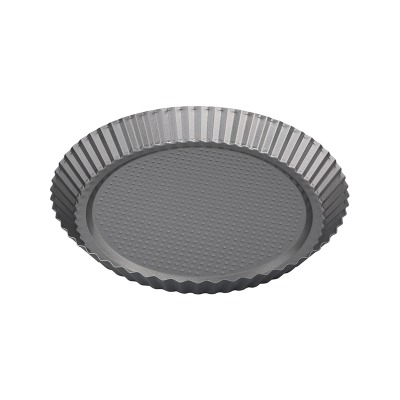Carbon steel is a durable material that combines strength with reliable thermal conductivity. Unlike some other materials, carbon steel heats quickly and retains heat well, making it suitable for tasks that require uniform cooking temperatures. This is particularly important when baking pizza, where an evenly cooked crust can make all the difference. The heavy-duty nature of a carbon steel pizza plate means it can withstand regular use and handle the high temperatures often used in pizza ovens or conventional home ovens.

One of the key features of a carbon steel pizza pan is its ability to distribute heat evenly across the surface. Uneven heating can cause hot spots that burn parts of the crust while leaving other areas undercooked. Carbon steel's conductive properties help avoid this problem, resulting in a pizza with a well-cooked base, a crispy crust, and toppings that cook through properly. This even heat distribution also means that the pizza cooks more efficiently, potentially reducing cooking time.
The design of carbon steel pizza plates typically includes a flat surface with raised edges to hold the pizza in place during baking. Some models feature perforations or holes to allow steam to escape, which can help create a crispier crust by preventing sogginess. The combination of sturdy construction and thoughtful design makes carbon steel pizza plates versatile for use in a variety of ovens, including traditional, convection, and outdoor pizza ovens.
Beyond pizza, carbon steel pans are available in other forms, such as muffin pans, which also benefit from the material's thermal properties. A carbon steel muffin pan provides even heat around each cup, allowing muffins and cupcakes to bake uniformly. This reduces the chances of uneven rising or burning on the edges. The heavy-duty construction means these pans hold their shape well even after repeated use and high-temperature baking.
One advantage of carbon steel bakeware, including pizza and muffin pans, is that they often come with a natural non-stick surface that develops over time with seasoning and use. This seasoning process creates a thin layer of polymerized oil that helps prevent food from sticking, similar to cast iron cookware. Regular maintenance, such as cleaning with gentle soap and oiling after use, helps preserve this non-stick quality and extends the lifespan of the pans.
When choosing a carbon steel pizza plate or muffin pan, size and thickness are important considerations. A thicker plate can retain heat longer and provide a sturdier base for heavy toppings, but it may take slightly longer to heat up initially. Conversely, a thinner pan heats quickly but might cool down faster once food is placed on it. Selecting the right thickness depends on cooking preferences and oven types.
Cleaning and care for carbon steel pans differ somewhat from other metal bakeware. It is generally recommended to avoid soaking carbon steel pans in water for extended periods, as this can cause rust. Instead, wipe them clean promptly after use and dry thoroughly. Seasoning the pan occasionally can help maintain its condition and prevent corrosion.
In everyday kitchens, a heavy-duty carbon steel pizza plate is a practical choice for those who enjoy homemade pizzas. Its ability to provide consistent heat and durability makes it a reliable tool, whether baking thin-crust pizzas, thick deep-dish styles, or even flatbreads. Similarly, a carbon steel muffin pan offers a dependable option for baking batches of muffins or cupcakes with consistent results.
Overall, carbon steel bakeware combines the benefits of traditional materials with modern cooking demands. Its versatility allows it to be used not only for pizzas and muffins but also for roasting vegetables, baking cookies, and more. For cooks looking for cookware that handles heat well and delivers consistent performance over time, carbon steel pizza and muffin pans are worth considering.

 English
English 中文简体
中文简体 Deutsch
Deutsch